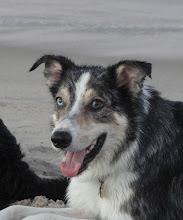Customing Platform Work
I have been working with Bandit on platforms to assist him with learning positions.
Strictly speaking, platform work is supposed to be shaped. The initial "four on the platform" behavior is shaped, and then the platform becomes "magnetized" as the dog is heavily reinforced for putting four paws on it.
Then the platform is placed in position and the dog learns to come into position, though a shaping-with-props process, the positions are put on cue, and the platforms are faded.
As I have been working with Bandit on the platforms, we have encountered a bit of a difficulty. Bandit does a beautiful job coming into front position on the platform. No surprise there - it is most natural, even if he is coming into position from beside me, to move into a position where he is facing me. But we have run into problems when I have moved the platform into heel and side position.
I have done the step where he remains on the platform and I move around and click/treat so he can get the feel for proper position. I have worked a gradual approach to the platform.
However, we consistently reach a point as the criteria increases and he is approaching the platform from a more difficult angle, where he gets stuck.
He will get onto the platform backwards so he is in heel or side position, but facing behind me (which would be fine if we were working on that, but we aren't!). Or, he will start to avoid the platform altogether and start to circle me.
If I were seeing some degree of enjoyment on his part, in working to figure out what I want through the shaping process, I would continue with it. I might break it back down a bit, and raise criteria more slowly. However, I was clearly see frustration on his part. Any learning that was happening was not the learning that I want to happen.
When I see frustration, I know it is time to reconsider my approach. The last thing I want to do is for Bandit to associate platforms with frustration. We had that experience with some pieces of Agility equipment, and it took some work to un-do the damage that was done.
So, I decided to help Bandit by giving him a clear hand cue to indicate that he should head to the rear of the platform. Once he did that, I could remove the hand and he would get into position.
Success!!
Here is a video of our first session doing this. There is some front work first.
After sharing the video, I was asked by a friend, "Why did you use the hand? Why didn't you shape it?"
That is an excellent question!
The reason is simply this: after careful consideration, taking Bandit's learning style and training history into account, I deduced that giving him a quick hand target was the best way to help him learn.
It was not so much a matter of him getting the idea quickly, but of him getting the idea without dealing with undue frustration.
Don't get me wrong - frustration is a reality in training. But I do feel very strongly that it ought to be minimized, and if it is going to be detrimental to the training process, it should be avoided if at all possible.
In this case, I could see the potential of creating an actual issue, and I did not want to do that. Add to that, I knew of a way to convey what I want to Bandit in a way that is very clear to him and has the potential to facilitate learning effectively.
So, I chose a training tool (hand target) that is very clear to Bandit, and he got the idea very quickly.
I expect that within two - three more sessions, he going to be getting onto that platform from any direction without me having to give the hand cue.
Let's see what happens!


0 Comments:
Post a Comment
<< Home